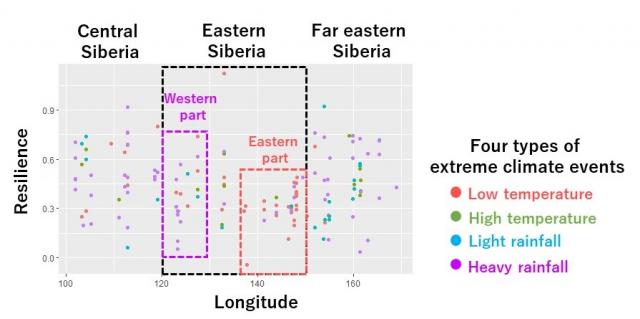Home > International Partnerships > Collaborative Research > Vulnerability of Larch Trees to Extreme Weather Events in Permafrost Ecosystem of Eastern Siberia
Update:June 6, 2024
Main content starts here.
Vulnerability of Larch Trees to Extreme Weather Events in Permafrost Ecosystem of Eastern Siberia

1. Partners
Institute for Biological Problems of Cryolithozone, Siberian Branch of the Russian Academy of Sciences, Russia
2. Research Period
FY 2020-2023 Grant-in-Aid for Scientific Research (KAKENHI)
3. Lead Researcher
TEI, Shunsuke (Department of Forest Management)
4. Background
With global warming, the frequency and intensity of extreme weather events have increased worldwide, and it is predicted that they will continue to increase in the future. Nevertheless, the impacts of extreme weather events on forest ecosystems remain unclear. In this project, we aim to evaluate such impacts, with a focus on forest ecosystems in Eastern Siberia, which are located in the permafrost zone and are particularly vulnerable to climate change.
5. Research Goal
We aim to evaluate the response and vulnerability of larch trees (the dominant tree species in Eastern Siberia) to extreme weather events.
6. Research Strategy
We intend to establish a novel individual-based dendroecology. In this approach, we evaluate the past growth variation pattern of individual trees from the chronological record of tree-ring widths. We then evaluate the response and vulnerability of larch tree growth to extreme weather events of various types, scales, and durations, which have been observed over the past decades, taking into consideration the size characteristics of individual trees and the microtopographical characteristics of their habitat.
7. Scientific Achievement
Due to the coronavirus disease (COVID-19) and the Russian-Ukrainian crisis, we are unable to conduct the originally planned field survey in Eastern Siberia. Therefore, we shifted to data analysis with tree-ring width chronologies of 33 sites in Eastern Siberia (60<N, 120<E<150) that are registered in the International Tree-Ring Data Bank (Fig.1). We found that sites with low resilience to past extreme climate events (especially extreme low temperatures) are predominantly distributed in the eastern part of eastern Siberia (Fig. 2). In addition, the low resilience of sites located in the eastern part of eastern Siberia was found to be more pronounced in comparison with sites in central and far eastern Siberia.

Fig1: Tree-ring based estimates of resistance, recovery, and resilience during a tree growth reduction event (a year in which the tree growth of at least 70% of individuals at a site decreased by 30% or more from the average growth over the previous 5 years). Average tree growth for the 5 years before and after the event are indicated as preGr and postGr, respectively

Figure 2: Relationship between site longitude and resilience during tree growth reduction events due to four types of extreme climate events (extreme low/high temperature, light/heavy rainfall; indicated by different colored plots). It can be found that the climate variables contributing to the event are dominated by heavy rainfall in the west and low temperatures in the east, and that sites with relatively low values for resilience are distributed in the east part of eastern Siberia.
8. Applications
Results in this project contribute to a better understanding of tree response and vulnerability to extreme climate events in Eastern Siberia, and to improved predictions of tree growth dynamics under future climate change.
9. Publications
Tei, S., Vulnerability and resilience of larch tree growth to climate changes in eastern Siberia. Abstract for International Symposium on ”Pan-Arctic Water -Carbon Cycles and Terrestrial Changes in the Arctic: For resilient Arctic Communities, 2022.03.
Tei, S., Spatio-temporal variation in vulnerability and resilience of tree radial growth to climate changes in Eastern Siberia. Proceedings of Japan Geoscience Union Meeting 2022, 2022.05.
Tei, S., Tree growth vulnerability to severe drought and cold events in Eastern Siberia. Abstract for the 71st Annual Meeting of the Ecological Society of Japan, 2024.03.
Copyright © Forest Research and Management Organization. All rights reserved.
